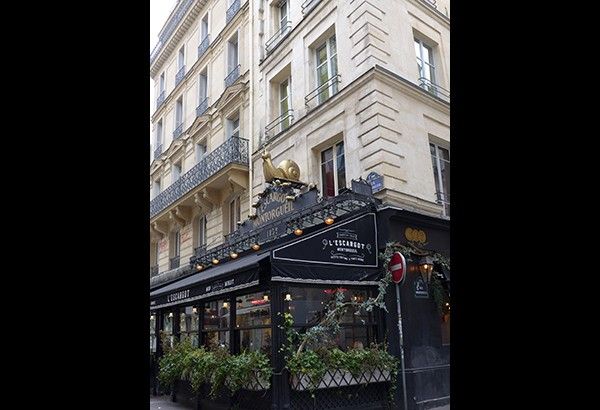The streets of Paris are steeped in history

History has always played a role in the streets of Paris. Parisians live in apartments knowing that a patriot, a scientist, an artist, or a mistress lived in the same place before. The French dictionary defines the word histoire as both “history” and “story.” And these streets, wide and narrow, are a witness to history and people’s stories.
Numerous museums and edifices feature famous artists and writers, past and present. The Grand Palais, built in 1897 as “a monument dedicated to the glory of French art,” has hosted a continuous stream of art and fashion expositions, except in World War I when it was used as a military hospital. Recently, the Victoria’s Secret models’ “secret” show was staged there — only for the second time outside the United States — to the music of Lady Gaga and Bruno Mars. (No wonder there was always a starstruck crowd in front of the Mandarin Oriental Hotel, hoping to catch a glimpse of Kendall Jenner, perhaps, or other celebs as they walked out to shop.)
While there are superlative events that show up on billboards inside the Metro, Paris offers so much more with its “pedestrian” experiences.
In the footsteps of Honoré de Balzac, who constantly walked the streets to find subject matter to write about, there is no other way to feel the pulse of Paris than by walking through its neighborhoods. The past is never forgotten — plaques on the walls and sidewalks name the people who lived and died there — and life goes on, making yesterday a part of history. While some addresses could be a restaurant or a bar today, other places still carry the same items they sold a century ago. In fact, many shops proudly include a “depuis” (meaning “since”) on their signs, stating which year they opened. Old is normal — and good.
Rue Montorgueil: Classic Food
Rue Montorgueil is one of the last food-oriented neighborhoods in Paris. Its butchers, fishmongers, fruit vendors, and patissiers have satisfied the appetites of gourmets, connoisseurs and regular folk for many generations. Historically, the name comes from the hill it ascends towards — Mont Orgueilleux — and it was the primary artery to Les Halles, which was then the official central Paris marketplace as decreed by King Philippe Auguste in 1183. It was the depository of fresh oysters from the whole northwest coast. Even Marie-Antoinette was a customer!
On this street, you will find Escargot Montorgueil, a restaurant with a golden snail at the entrance canopy — a bit touristy, but it prides itself on having served its steaming specialty to famous people like Sarah Bernhardt, Marcel Proust, Charlie Chaplin, Jean Cocteau, Picasso and Salvador Dali; Patissier Nicolas Stohrer (the pastry chef of Marie Leszczynska, daughter of King Stanislaus of Poland, who married Louis XV in 1735) is said to have invented the dessert Bàba au rhum, named in honor of Ali Baba; while G. Detou (the name means “I have everything”) is a 65-year-old institution where chefs and foodies find their baking needs.
A walk through rue Montorgueil’s food and wine shops will equip you with everything you need for a picnic lunch on the banks of the Seine!
Rue De Mouffetard: Home To Famous Writers
Rue de Mouffetard’s Place de la Contrescarpe is a charming, tiny roundabout, with a gleaming fountain and trees — a pleasant shady place surrounded by many cafes, restaurants, crêperies. The apartment on 6 rue de Pot-de-Fer was the home of George Orwell, the penname of Eric Arthur Blair, where he wrote Down and Out in Paris and London in 1933. (He wrote 1984 in 1949.) His biography cites that while he wasn’t born poor, he wanted to feel what that was like by working as a plumber in Paris. Ernest Hemingway moved to 74 rue de Cardinal Lemoine in 1922, a stone’s throw away. James Joyce is said to have finished Ulysees in his home at 7 rue Edmond Valentin.
Pigalle: The He(Art) Of Paris
Pigalle, rue Condorcet and rue Martyrs have had a sleazy reputation — full of bars, sex shops and strip joints, where tourists can be ripped off. But these perceptions are changing. The sleaze is quickly being replaced by glitz and glamour, with gourmet food stores, art galleries and boutiques that also have branches in the Marais and Saint-Germain de-Prés. A walk on this street leads you up the hill to the Sacre Coeur and the Moulin de la Galette (aka Le Moulin Blute-Fin), one of only two remaining windmills still in existence in Paris. There were more than a dozen that once stood on Montmartre in the 17th century.
A blur from a tourist bus, these streets were witnesses to events that are now remembered with a monument, a plaque, a concrete mark on the ground. This is perhaps the reason that Paris should initially be taken in a grand sweep, but revisited again and again to discover her intimate charm on foot.
Do wear comfortable shoes, hide your wallet where skilled fingers cannot reach it and hit the streets: get lost and discover a truer Paris.
* * *
Tell me where to Walk the Talk: cecilialicauco2@gmail.com. Follow me on Instagram: cecilialicauco2.















